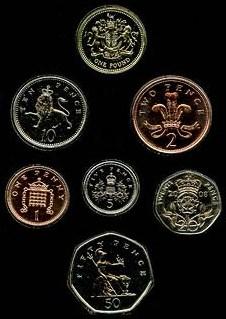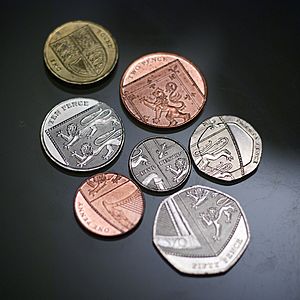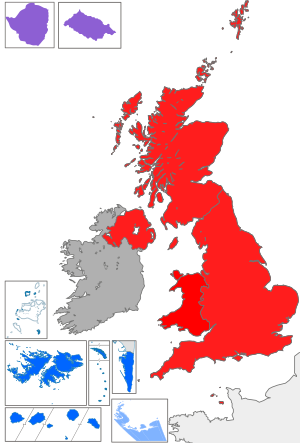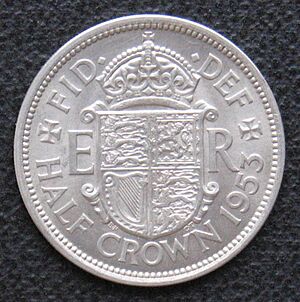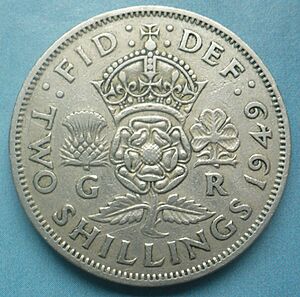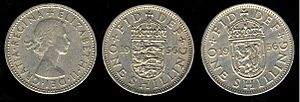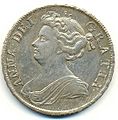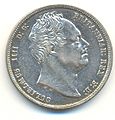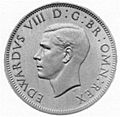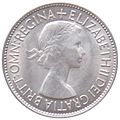Coins of the pound sterling facts for kids
The coins we use in the United Kingdom, its Crown Dependencies, and British Overseas Territories are called pounds (symbol "£") and pennies. These coins range from one penny to two pounds.
Since 15 February 1971, which was called Decimal Day, one pound has been divided into 100 (new) pence. Before that, the system was different: twelve pence made a shilling, and twenty shillings made a pound.
British coins are made by the Royal Mint in Llantrisant, Wales. The Royal Mint also decides what the coins will look like.
Besides the coins we use every day, the UK also makes special commemorative coins worth five pounds. There's also Maundy money for ceremonies, and special gold sovereigns, half sovereigns, and gold and silver Britannia coins. Some places outside the UK that use the pound sterling make their own coins. These coins have the same values and sizes as UK coins but feature local designs.
Contents
Coins We Use Today
The coins currently in circulation are:
- One penny and two pence coins are made of steel with a copper coating.
- Five pence and ten pence coins are made of steel with a nickel coating.
- Twenty pence and fifty pence coins are shaped like a special seven-sided shape called an equilateral curve heptagon. They are made of cupronickel.
- One pound and two pounds coins are made of two different metals, so they are called bimetallic.
All these coins have a picture of the monarch's head on one side, called the obverse. The other side, the reverse, has different designs, some showing national symbols or special events. The coin's value is also shown in numbers or words.
- Elizabeth II
- Coins made during Elizabeth II's reign have a Latin phrase that means "Elizabeth II, by the grace of God, Queen and Defender of the Faith". The value is usually on the back.
- Charles III
- Coins made during Charles III's reign have a Latin phrase that means "Charles III, by the grace of God, King and Defender of the Faith". The value can be on either side.
| Denomination | Obverse | Reverse | Diameter | Thickness | Mass | Composition | Edge | Introduced |
|---|---|---|---|---|---|---|---|---|
| One penny | Queen Elizabeth II | Crowned portcullis with chains (1971–2008) Segment of the Royal Arms (2008–present) |
20.3 mm | 1.52 mm | 3.56 g | Bronze (97% copper, 2.5% zinc, 0.5% tin) | Smooth | 1971 |
| 1.65 mm | Copper-plated steel | 1992 | ||||||
| Two pence | Plume of ostrich feathers within a coronet (1971–2008) Segment of the Royal Arms (2008–present) |
25.9 mm | 1.85 mm | 7.12 g | Bronze | 1971 | ||
| 2.03 mm | Copper-plated steel | 1992 | ||||||
| Five pence | Queen Elizabeth II | Crowned thistle (1968–2008) Segment of the Royal Arms (2008–present) |
18 mm | 1.7 mm | 3.25 g | Cupronickel (3:1) | Milled | 1990 |
| 1.89 mm | Nickel-plated steel | 2012 | ||||||
| Ten pence | Crowned lion (1968–2008) Segment of the Royal Arms (2008–present) |
24.5 mm | 1.85 mm | 6.5 g | Cupronickel (3:1) | 1992 | ||
| 2.05 mm | Nickel-plated steel | 2012 | ||||||
| Twenty pence | Crowned Tudor Rose | 21.4 mm | 1.7 mm | 5 g | Cupronickel (5:1) | Smooth, Reuleaux heptagon | 1982 | |
| Segment of the Royal Arms | 2008 | |||||||
| Fifty pence | Britannia and lion | 27.3 mm | 1.78 mm | 8 g | Cupronickel (3:1) | Smooth, Reuleaux heptagon | 1997 | |
| Various commemorative designs | 1998 | |||||||
| Segment of the Royal Arms | 2008 | |||||||
| King Charles III | 1953 Queen's coronation commemoration | December 2022 | ||||||
| One pound | Queen Elizabeth II | Rose, leek, thistle, and shamrock encircled by a coronet | 23.03–23.43 mm | 2.8 mm | 8.75 g | Inner: Nickel-plated alloy Outer: Nickel-brass |
Alternately milled and plain (12-sided) | 28 March 2017 |
| Two pounds | Abstract concentric design representing technological development | 28.4 mm | 2.5 mm | 12 g | Inner: Cupronickel Outer: Nickel-brass |
Milled with variable inscription and/or decoration | 1997 (issued 1998) | |
| Various commemorative designs | 1999 | |||||||
| Britannia | 2015 |
How Coins Are Made and Used
All real UK coins are made by the Royal Mint. The same coins are used all over the United Kingdom. Unlike banknotes, different parts of the UK don't have their own special coins.
Every year, new coins are checked to make sure they are the right size, weight, and made of the correct metals. This check is called the Trial of the Pyx. This process has been used since the 1200s!
The 1p and 2p coins from 1971 are the oldest regular coins still used today. Coins from British territories that use the pound are sometimes found in the UK. They aren't officially "legal tender" in the UK, but they look the same and often work in vending machines.
UK coins are usually accepted in other British territories that use the pound.
In 2005, the Royal Mint decided to change the designs of many coins. New designs were slowly introduced starting in 2008. The older coins from before 2008 are still valid and will stay in use for a long time.
Here's how many coins were estimated to be in circulation in March 2016:
| Denomination | Number of pieces (millions) |
Face value (£m) |
|---|---|---|
| Two pounds | 479 | 957.036 |
| One pound | 1,671 | 1,671.328 |
| Fifty pence | 1,053 | 526.153 |
| Twenty-five pence | 81 | 20 |
| Twenty pence | 3,004 | 600.828 |
| Ten pence | 1,713 | 171.312 |
| Five pence | 4,075 | 203.764 |
| Two pence | 6,714 | 134.273 |
| One penny | 11,430 | 114.299 |
| Total | 30,139 | 4,643.658 |
History of British Coins
Long ago, the Anglo-Saxon kingdoms in England copied a money system from Europe. This system used 12 pence to a shilling and 20 shillings to a pound. This is where the names for our current money, "pound" and "penny," came from. For many centuries, only pennies were made as actual coins; shillings and pounds were just ways to count money.
The Penny Before 1500
The English silver penny first appeared around the 700s. For 500 years, from about 780 to 1280, the silver penny was the only coin made.
At first, English silver coins were made from very pure silver. But pure silver coins wore out quickly and could be easily "clipped" (trimmed) by dishonest people to steal some of the silver. In 1158, Henry II introduced a new standard for coins called "sterling silver". This was 92.5% silver and 7.5% copper. This mix was stronger and helped stop clipping.
The weight of a silver penny changed over time. It was more than 22 grains until 1344, then it got lighter in later years.
The Royal Mint, where coins are made, has been around since 886 AD. For many centuries, coins were made in London. In the 1970s, the Royal Mint moved to Llantrisant in South Wales. Scotland and England used to have their own coins, but after they joined together in 1707, they started using the same money.
The Penny After 1500
During Henry VIII's time, the amount of silver in coins was reduced a lot. But in 1551, during Edward VI's reign, they went back to using sterling silver. From then until 1920, sterling silver was the rule for coins.
Coins were first made by hand-hammering them. This was an old method where two dies (metal stamps) were hit together with a blank coin in between. But from 1662 onwards, all British coins have been "milled," meaning they were made by machines.
By 1601, it was decided that one troy ounce of sterling silver would be made into 62 pennies. Around 1696, many coins were damaged by clipping. Isaac Newton, a famous scientist, helped fix this problem when he worked at the Royal Mint. He made sure all the old, clipped silver coins were replaced. After England and Scotland joined in 1707, Newton also helped create a single currency for the new Kingdom of Great Britain.
In 1717, a change was made that accidentally led Britain to use a gold standard instead of a silver standard. This meant gold coins became more important for trade.
In 1816, new rules were set for the weight and size of silver coins. In 1920, the silver in British coins was reduced to 50%. After 1947, silver was removed from most coins completely, except for special Maundy money.
The old weight and size system lasted even after decimalization in 1971 for some coins. But in 1992, smaller, more convenient "silver" coins were introduced.
History of Decimal Coins
Decimalization
On 15 February 1971, the UK changed its money system to "decimalization." This meant that one pound was now divided into 100 pence. Before this, a pound was 20 shillings, and each shilling was 12 old pence, making 240 old pence in a pound. The UK kept the pound as its main currency unit, unlike some other countries that changed to dollars.
Here are the first decimal coins and their designs:
- Half penny (1971–1984): A crown, representing the monarch.
- One penny (1971–2007): A crowned portcullis with chains (the symbol of the Houses of Parliament).
- Two pence (1971–2007): The Prince of Wales's feathers.
- Five pence (1968–2007): The Badge of Scotland, a crowned thistle.
- Ten pence (1968–2007): The crowned lion of England.
- Fifty pence (1969–2007): Britannia and a lion.
The first decimal coins, the 5p and 10p, were introduced in 1968 to help people get used to the new system. They were the same size and value as the old one-shilling and two-shilling coins. The 50p coin came out in 1969, replacing the old ten-shilling banknote. The rest of the decimal coins (half penny, 1p, and 2p) were released in 1971.
The new coins initially said "NEW PENNY" or "NEW PENCE." The word "new" was removed in 1982. The symbol "p" was used for the new pence, different from the old "d" (from the Latin word denarius).
Changes from 1982 to 1998
Since decimalization, some changes have been made to the coins. New coins were introduced with these designs:
- Twenty pence (1982–2007): A crowned Tudor Rose, a symbol of England.
- One pound (1983–2016): Many different designs.
- Two pounds (1997–2014): An abstract design showing how technology has developed.
Other changes include:
- The halfpenny coin was stopped in 1984 because it was worth too little.
- The 1p and 2p coins changed from bronze to copper-plated steel in 1992.
- The 5p, 10p, and 50p coins were made smaller in the 1990s.
The 20p coin was added in 1982. The £1 coin was introduced in 1983 to replace the £1 banknote. The designs on the £1 coin changed every year until a new 12-sided £1 coin was introduced in 2017.
The old pre-decimal coins like the sixpence, shilling, and two-shilling coins were eventually removed from circulation. The double florin and crown coins are technically still valid but are almost never seen.
Since 1997, many special commemorative 50p coins have been made. Some are common, others are rare, but all are legal tender.
In 1992, the 1p and 2p coins changed from bronze to copper-plated steel. The old bronze coins had a high copper content, so by 2006, the metal in them was worth more than their face value if melted down.
A new two-pound (£2) coin was introduced in 1998. Before this, £2 coins were only made for special occasions and didn't usually circulate. Many commemorative £2 coins have been made since then.
Special crowns are also made. Until 1981, they were worth 25p. But in 1990, their value was changed to £5 because 25p was considered too low for such a special coin. These £5 coins are usually collected and not used for everyday shopping.
Monarch's Profile on Coins
All modern British coins show a side profile of the current monarch's head. Since the 1600s, the direction the monarch faces changes with each new ruler. For example, if one monarch faces right, the next will face left.
The coins usually have a Latin phrase that means "Elizabeth II, by the grace of God, Queen and Defender of the Faith" (for Queen Elizabeth II) or "Charles III, by the grace of God, King and Defender of the Faith" (for King Charles III). This phrase is often shortened to fit on the coin.
2008 Coin Redesign
In 2008, UK coins got a big makeover. The backs of almost all coins were changed. The main new feature was a design spread across six coins (1p, 2p, 5p, 10p, 20p, 50p). When you put these coins together, they form a picture of the Royal Shield. This was the first time a coin design was split across multiple coins like this.
Here's what the new designs show:
- The 1p coin shows part of the English lions and the Irish harp.
- The 2p coin shows most of the Scottish lion.
- The 5p coin shows the center of the shield.
- The 10p coin shows most of the three English lions.
- The 20p coin shows parts of the Scottish lion and English lions.
- The 50p coin shows the bottom of the shield, with the Irish harp and English lions.
- The round £1 coin (from 2008 to 2016) showed the whole Royal Shield. From 2017, the £1 coin became 12-sided and shows a rose, leek, thistle, and shamrock under a crown.
- The £2 coin from 2015 shows Britannia.
The small dots around the edge of the front of the coins were removed. The year was moved to the front of the 20p coin. The 50p coin was also rotated. The numbers showing the value were removed from most coins, leaving only the words.
This redesign was chosen from a public competition. The winning design was by Matthew Dent. The Royal Mint said the new designs showed "a twenty-first century Britain."
Some people criticized the new designs because they didn't include a specific Welsh symbol like the Welsh Dragon. However, the Royal Mint explained that the Royal Shield represents all parts of the UK, including Wales.
Changes After 2008
Since 2012, 5p and 10p coins are made of nickel-plated steel. This change was made to save money on more expensive metals. The new coins are a bit thicker but weigh the same.
In 2016, the £1 coin changed from a round, single-metal coin to a 12-sided coin made of two metals. The new £1 coin started circulating on 28 March 2017.
In 2015, the Royal Mint announced a new design for the £2 coin featuring Britannia.
The edges of £2 coins often have special words or patterns. The standard £2 coin from 1997 to 2015 had the words "STANDING ON THE SHOULDERS OF GIANTS" on its edge. The newer £2 coin from 2015 has "QUATUOR MARIA VINDICO," which is Latin for "I will claim the four seas."
Old Coins No Longer Used
The following decimal coins have been removed from circulation and are no longer valid for everyday use.
| Denomination | Obverse | Reverse | Diameter | Thickness | Mass | Composition | Edge | Introduced | Withdrawn |
|---|---|---|---|---|---|---|---|---|---|
| Half Penny | Queen Elizabeth II | St Edward's Crown | 17.4 mm | 1 mm | 1.78 g | Bronze | Smooth | 1971 | 1984 |
| Five pence* | Queen Elizabeth II | Crowned Thistle | 23.59 mm | 1.7 mm | 5.65 g | Cupronickel | Milled | 1968 | 1990 |
| Ten pence* | Crowned Lion | 28.5 mm | 1.85 mm | 11.31 g | 1992 | ||||
| Fifty pence* | Seated Britannia alongside a Lion | 30.0 mm | 2.5 mm | 13.5 g | Smooth, Reuleaux heptagon | 1969 | 1997 | ||
| Various commemorative designs | 1973 | ||||||||
| One Pound† | Queen Elizabeth II | Numerous different designs | 22.5 mm | 3.15 mm | 9.5 g | Nickel-brass | Milled with variable inscription and/or decoration | 1983 | 15 October 2017 |
| Royal Shield | 2008 | ||||||||
| Two pounds | No standard reverse design | 28.4 mm | ~3 mm | 15.98 g | Nickel-brass | 1986 | 1998 |
* The specifications and dates of 5p, 10p, and 50p coins refer to the larger sizes issued since 1968.
† The specification refers to the round coin issued from 1983 to 2016. Although obsolete, this coin is still redeemable at banks and the British railway systems, and is still legal tender on the Isle of Man.
Special Commemorative Coins
Circulating Commemorative Designs
Some fifty pence and two pound coins are made with special designs to celebrate historical events or famous people. These coins are meant to be used in everyday shopping.
For example, large 50p coins were made in 1973 (for the European Community), 1992–3 (for the EC presidency), and 1994 (for D-Day). Many different designs for the smaller 50p coin have been issued since 1998.
Before 1997, £2 coins were only made for special occasions. Since 1999, many commemorative £2 coins have been issued alongside the regular ones. These coins often have a special message on their edge.
From 2018 to 2019, a series of 26 different 10p coins were released, celebrating British things from A to Z.
Coins Not Meant for Circulation

Some coins are made as special collectibles and are sold for more than their face value. They are usually still legal tender, meaning they can be used to pay debts, but people usually keep them because they are valuable to collectors. For example, a 50p coin featuring Harry Potter was announced in 2023. A standard one sells for £11, while a gold version with a £200 face value sells for over £5,000!
Here are some special commemorative coins that are rarely seen in everyday use:
- Twenty-five pence or crown (25p; £0.25), 1972–1981
- Five pounds or crown (£5), 1990–present
- Twenty pounds (£20), 2013–present
- Fifty pounds (£50), 2015–2016
- One hundred pounds (£100), 2015–2016
| Denomination | Obverse | Reverse | Diameter | Thickness | Mass | Composition | Edge | Introduced |
|---|---|---|---|---|---|---|---|---|
| 25 pence | Queen Elizabeth II | No standard reverse design | 38.61 mm | 2.89 mm | 28.28 g | Cupronickel or silver | Milled, with variable inscription | 1972 |
| 5 pounds | 1990 | |||||||
| 20 pounds | 27.0 mm | Unknown | 15.71 g | Silver | Milled | 2013 | ||
| 50 pounds | Britannia | 34.0 mm | 31 g | 2015 | ||||
| 100 pounds | Elizabeth Tower 'Big Ben' | 40.0 mm | 62.86 g |
Maundy Money
Maundy money is a special ceremonial coin given out once a year to deserving older citizens. These coins come in one, two, three, and four pence values. They are made in very small numbers and are rarely seen in circulation, even though they are legal tender.
Maundy coins still show the very first portrait of Queen Elizabeth II used on coins when she became queen.
Bullion Coins
Britain also makes special "bullion" coins, which are mainly bought for their metal value (like gold or silver) rather than their face value. The most famous is the gold sovereign. The Royal Mint still makes sovereigns, as well as smaller and larger versions.
Between 1987 and 2012, a series of gold bullion coins called "Britannias" were made. Since 2013, these gold Britannias are made of even purer gold. Silver Britannias have also been made since 1997.
In 2016, the Royal Mint started a series of 10 "Queen's Beasts" bullion coins, featuring mythical creatures.
Non-UK Coins
Outside the UK, places like Jersey and Guernsey (British Crown Dependencies) use the pound sterling. However, they make their own coins with different designs, though they have the same values and sizes as UK coins. These coins are used freely in those places, but you might need to exchange them to use them in the UK. The Isle of Man also has its own coins, which are not legal tender in the UK.
Other British overseas territories like Gibraltar, the Falkland Islands, and Saint Helena also have their own currencies. These currencies are worth the same as the pound sterling, but they are technically separate and have their own unique coin designs.
Old Pre-Decimal Coins
Before decimalization in 1971, the pound was divided differently. It was split into 20 shillings, and each shilling was 12 pence. So, one pound was equal to 240 old pence.
Here's how it worked:
- £1 = 20 shillings (20s)
- 1 shilling = 12 pence (12d)
So, £1 = 240d. The penny itself could be divided into smaller parts, like halfpennies and farthings, but these became less important over time.
When writing amounts, people would say "5s 6d" or "5/6" for five shillings and sixpence. "5/-" meant five shillings exactly. The "d" for penny came from the Roman word denarius, and "s" for shilling came from solidus. The "£" for pound comes from the Latin word libra.
Old Coin Values
Just before decimalization, these were the common British coins:
| Denomination | Obverse | Reverse | Diameter | Thickness | Mass | Composition | Edge | Introduced | Withdrawn |
|---|---|---|---|---|---|---|---|---|---|
| Farthing (1⁄4d) | Various Monarchs | Wren (Britannia on early mintages) | 20.19 mm | 2.83 g | Bronze | Smooth | 1860 | 1961 | |
| Half penny (1⁄2d) | Golden Hind (Britannia on early mintages) | 25.48 mm | 5.67 g | 1969 | |||||
| Penny (1d) | Britannia | 31 mm | 9.45 g | 1971 | |||||
| Threepence (3d) | King George VI 1937–1952 Queen Elizabeth II 1953–1971 |
Thrift until 1952 Crowned portcullis with chains | 21.0–21.8 mm | 2.5 mm | 6.8 g | Nickel-brass | Plain (12-sided) | 1937 | 1971 |
| Sixpence (6d) | King George VI 1946–1952 Queen Elizabeth II 1953–1971 |
Crowned royal cypher until 1952 Floral design – Four Home Nations | 19.41 mm | 2.83 g | Cupronickel | Milled | 1947 | 1980 | |
| Shilling (1/-) | Crowned lion on Tudor crown or Crowned lion standing on Scottish crown until 1952 Coat of Arms of England or Scotland | 23.60 mm | 1.7 mm | 5.66 g | 1990 | ||||
| Florin (2/-) | Crowned rose flanked by a thistle and shamrock until 1952 Rose encircled by thistle, leek and shamrock | 28.5 mm | 1.85 mm | 11.31 g | 1992 | ||||
| Half crown (2/6) | Royal Shield flanked by crowned royal cypher until 1952 Crowned Royal Shield | 32.31 mm | 14.14 g | 1969 | |||||
| Crown (5/-) | Various commemorative designs | 38 mm | 2.89 mm | 28.28 g | 1951 | Present |
The farthing (1⁄4d) was stopped in 1961. The crown (5/-) was mostly a special coin and not used daily.
The crown, half crown, florin, shilling, and sixpence were made of cupronickel (or silver in older times). The penny, halfpenny, and farthing were bronze. The threepence was a twelve-sided coin made of nickel-brass.
Some old coins, like the shilling (which became 5p) and florin (which became 10p), continued to be used after 1971 alongside the new decimal coins for a while. But they were eventually replaced by smaller versions.
Slang for Old Coins
Many old coins had nicknames. A shilling was called a bob. A pound was called a quid. A sixpence was a tanner. The two-shilling coin (florin) was a two-bob bit. A half-crown (two shillings and sixpence) was sometimes called a half-dollar.
Even today, people still use quid for a pound. In some areas, bob is still used to mean five new pence.
When talking about decimal money, people often say "pee" after the number, like "twenty-three pee." For amounts over a pound, it's usually "five pounds forty."
Monarch's Profile on Coins
All coins since the 1600s have shown a side view of the current monarch's head. The direction they face changes with each new monarch. For example, Queen Victoria faced left, so Edward VII faced right.
There was a small exception with Edward VIII. He became king in 1936 and was shown facing left, the same as his father, George V. This was against tradition, but Edward thought his left side looked better. However, he gave up the throne before his coins were widely used. So, when George VI became king, his coins showed him facing left, as if Edward VIII's coins had followed the tradition and faced right.
Royal Titles on Coins
From very early times, British coins have had the ruler's name and title written in Latin. These titles were often shortened to fit on the coin. The words usually went around the edge of the coin, starting at the top.
For example, coins of Elizabeth I had a Latin phrase meaning "Elizabeth, by the Grace of God, of England, France, and Ireland, Queen." After the Acts of Union joined Great Britain and Ireland, the title changed to "King/Queen of the Britains." The claim to the French throne was dropped.
Later, titles like "Empress of India" were added for Queen Victoria and King George V. This title was removed in 1948 after India became independent. Modern coins simply say "Queen/King, Defender of the Faith," without naming specific realms.
Coin Mottos
Besides the monarch's title, some coins also had Latin or French mottos, usually on the back. These mottos varied and sometimes related to the monarch or general ideas.
Some examples of mottos:
- POSUI DEUM ADIUTOREM MEUM: "I have made God my helper." (Coins of Henry VII, Henry VIII, Elizabeth I).
- FACIAM EOS IN GENTEM UNAM: "I shall make them into one nation." (Coins of James I, showing his wish to unite England and Scotland).
- CHRISTO AUSPICE REGNO: "I reign with Christ as my protector." (Coins of Charles I).
- PAX QUÆRITUR BELLO: "Peace is sought by war." (Motto of Oliver Cromwell).
- BRITANNIA: "Britain." (Found on pennies and smaller coins from Charles II to George III).
- DECUS ET TUTAMEN: "An ornament and a safeguard." (Found on some pound and crown coins). This refers to the inscribed edge protecting the coin from clipping.
Minting Errors in Circulation
Sometimes, coins are made with mistakes during the minting process and accidentally get into circulation. Coin collectors often find these "error coins" very valuable.
- In 1983, some two pence coins were wrongly made with the old "New Pence" wording instead of "Two Pence."
- In 2016, some £1 coins were released with two different dates: '2017' on the front and '2016' in the micro-engraving.
- In 2009, between 50,000 and 200,000 20 pence coins were released without any date at all! This happened because old and new coin-making tools were mixed up.
Images for kids


